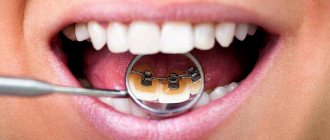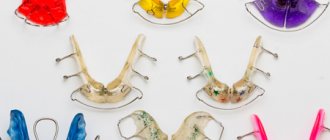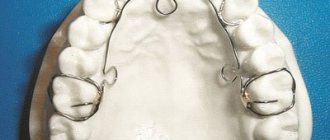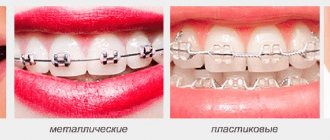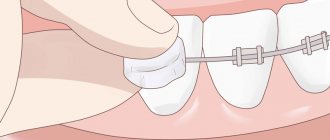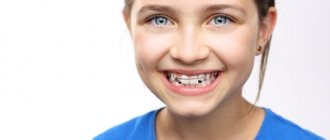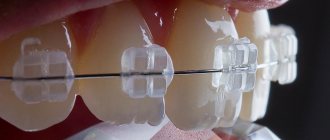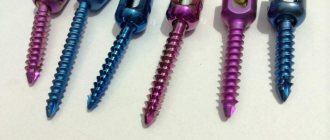One of the characteristics of teeth is mobility, and this quality allows orthodontists to change their position, correcting the bite. Therefore, the principle of operation of all orthodontic devices is similar - they set the direction for a gradual change in the position of the teeth.
For correction, different orthodontic systems are used - plates, aligners and braces. In this article we will tell you how they differ from each other.
Let's look at tools that help people feel free to smile
Plates for teeth
A plate is a removable orthodontic appliance that is used to correct malocclusion in children aged 6 to 13 years. The main purpose of this device is to expand the dentition.
Expansion of the dentition occurs due to the gradual unwinding of the screw in the center of the structure
The plate has a plastic base that follows the shape of the palate and the inner surface of the teeth. One or more screws are placed in the center, due to which the correction will occur. Plates solve the most common problem of crowding of teeth due to lack of space in the child's jaw.
Correction needs to be done once every month and a half. The orthodontist will gradually unscrew the screw, each turn expanding the plate by 0.25 mm. As a rule, pressure on the jaw is felt in the first 5–15 minutes after correction.
The plate may also contain elements for correcting individual teeth, for example, to correct tilt or rotation.
The duration of treatment with plates is on average 1.5–2 years. They are worn, depending on the doctor’s recommendations, from 18 to 24 hours a day.
The plate is removed when eating and brushing teeth
Plates are individual devices that are made for each patient. Depending on the clinical cases, single-jaw or double-jaw systems are used: from the name it is clear that the former correct one jaw, the latter – both at once.
Plates can also be made with artificial teeth - they are necessary if, for some reason, the child has lost milk teeth early. Early tooth loss can cause malocclusion, for example, when neighboring teeth begin to take the place of the missing one, and over time there is no place for the molar to erupt.
Comparison of popular brands of strips with each other
Dental strips are produced by many companies, one of the most famous is Crest 3D White. Crest 3D whitening strips are well known in many European countries, including our country. The stripes are divided into several categories: Vivid, Glamorous White, Supreme Flexfit, Professional Effects and 1-Hour Express. All of the listed types of strips are absolutely safe for health. Let's compare the characteristics of the two most common models.
Vivid is a budget option that allows you to achieve a lasting tone whitening effect that lasts for 8-10 months. Use once a day for 30 minutes per dose. The duration of the course is 10 days. Possibility to choose between two color tones.
Professional Effects is a more expensive and effective at-home whitening option. Allows you to whiten tooth enamel within two weeks, the choice of color tones has been increased to 5. Used once a day by applying to teeth for 1 hour. Thanks to the use of Advanced Seal technology, a tighter fit to the tooth surface is achieved, thereby enhancing the whitening effect.
Important to remember!
Do not forget that the choice of health products must be treated with special care. Counterfeits or simply low-quality products are not uncommon, so make your purchase in reliable places and after consulting a dentist. Also, teeth whitening in dentistry is always more effective and safe, because... takes into account your individual characteristics and is carried out on professional equipment customized for you. You need to treat enamel with special care, because... It will no longer be possible to restore it after damage, remember this.
Aligners
These are transparent removable mouth guards made of hypoallergenic material, which are used to correct bite in children over 12 years of age and adults. Age restrictions are due to the fact that aligners can be prescribed when jaw growth has stopped, that is, after 12–14 years.
Aligners are clear aligners that are less noticeable when worn than a plate or braces.
Aligners are prescribed when there are gaps between teeth that spoil the aesthetic appearance. They also help solve the problem of crowded teeth, change the position or inclination of each tooth, and correct crossbites or open bites. In severe cases or in very difficult cases, this orthodontic system will not be sufficient and braces may be required.
Like plates, aligners are individual for each client. They are created using a 3D model, taking into account how the position of the teeth will change step by step. That is, if the doctor adjusts the plate according to the schedule, then the aligners will simply need to be changed every 2-4 weeks on your own. A set can on average include from 8 to 40 sets, depending on the complexity of the case. As a rule, the first results become noticeable after 3-4 months of wearing.
The client receives a full set of aligners for the entire correction period
After treatment, a retention period begins, during which you need to consolidate the result with the help of retainers. If it is missed, the teeth may return to the position they were before treatment.
Aligners should be worn for 20–22 hours a day, only being removed when eating or brushing your teeth. The advantage of this device is that it does not impose dietary restrictions: for example, while wearing braces you cannot eat solid foods such as nuts, crackers, apples.
Russian Star Smile aligners have made the technology of orthodontic treatment with aligners accessible, since the final cost does not include transportation costs from abroad. In addition, their production time is reduced. The treatment process takes on average from 3 to 15 months.
Types of plates for teeth
There are two types of bite correction plates:
- Non-removable - fixed on the outer surface of the teeth. Their design includes a system of locks, through each of which a steel arc is threaded. The latter, restoring its original shape, sets the teeth in the required direction of movement. The time it takes to correct teeth with a non-removable plate is about two years, and the treatment method itself can be used for both children and adults;
- Removable ones have a simpler design compared to non-removable ones. They are made from plastics that are non-toxic to the human body. They are fixed to the teeth using metal hooks. In addition, their design may include auxiliary screws and springs. Removable teeth straightening plates can be removed while eating or brushing your teeth. The period of wearing them varies from one and a half to two years and is determined by the doctor.
Fixed dental plates, the price of which is significantly higher than their removable counterparts, are rightfully considered more effective. The choice of type depends on the complexity of the case.
In addition, classification is carried out based on the purpose of application. The types of plates are presented in the table below:
| Type of plates | What is it used for? | Peculiarities |
| Mechanical | Optimal for correcting crooked teeth and helping to straighten them. | They have clasps, arches and screws made of metal. |
| Equipped with a hand-shaped process | Allows you to correct an individual tooth. | The design is such that it allows you to apply pressure to one specific tooth. |
| Functional | They stimulate the development of the jaw and chewing muscles, allow you to restore facial muscles and even correct the shape of the face due to the restructuring of the dentition and the regulation of the temporomandibular joints. | Requires wearing for 14 hours a day. They fix the jaw in one position and are complex structures, when worn, the child cannot eat or speak. |
| Single jawed | Used to correct anomalies of individual teeth on one jaw. | The design includes special screws |
| Vestibular | They allow you to remove the soft tissue that has formed between the teeth by moving it away. | They are placed between the teeth and lips or between the teeth and cheek, depending on the location of the abnormal area. |
| With retraction type arc | Effective in straightening front teeth. | The plate is installed in such a way that it covers the teeth from the outside. |
| With arc with active pusher | Used to correct the palatal position of the upper teeth. | The arc has a base made of hypoallergenic plastic and a spring. |
Braces
This is a non-removable orthodontic system, which is especially relevant for severe bite defects. A lock is attached to each tooth on the outside or inside, depending on the type of braces, and they are connected to each other with arches. This puts constant pressure on the teeth, which forces them to change position, and the bite is corrected. Only a doctor can install, adjust or remove braces.
Braces consist of clasps and arches - the first are fixed on the teeth, the second connect them together
The brace system is a standard solution, so the doctor must conduct inspections quite often and manually adjust the direction of the arc. Mini-screws, elastic bands and silicone chains are often additionally used, which in themselves cause discomfort to patients. On average, treatment with braces takes from one to three years. After this, a consolidation period is required, when retention mouth guards are put on at night or permanent retainers are used - metal arches installed on the inner surface of the teeth.
While wearing braces, you need to visit an orthodontist for adjustments. On average, once every 3-4 weeks, the doctor changes the arches, which put pressure on the teeth.
The systems differ from each other in the method of fastening and material of manufacture. Thus, braces can be attached to the outside or inside of the teeth. In addition, they come in metal, ceramic or sapphire. In the first case, the locks are made of metal and are noticeable when worn. Ceramic ones are less visible on the teeth, since you can choose a color that is as close as possible to the shade of the enamel. Sapphire braces are made from synthetic clear sapphire and are less visible when worn.
Lingual braces are attached to the inside of the teeth, so they are visually invisible when worn.
Regardless of which treatment is chosen, the first step to correcting your bite is visiting your dentist. Make an appointment right now, and together we will select a correction system for you.
Disadvantages of dental plates
- Not all defects are corrected (severe malocclusions are usually corrected with the help of braces)
- Most often effective only in childhood
- Long term treatment (usually 1-2 years)
- Possible allergic reaction to plastic
Install a plate for teeth straightening in Minsk
Both adults and children can correct bite defects and uneven teeth using a dental plate at the Medexpert Family Dentistry Center in Minsk. Experienced orthodontists will select the most convenient design for you and help you acquire a beautiful and even smile with high quality, quickly and at affordable prices.
How to care for teeth with plates
Brushing teeth with orthodontic appliances in the mouth requires more attention. If a child has removable dental plates, then they must be removed when eating and brushing the teeth. Before putting them on again, the structures must be rinsed with clean water. It is better to store such records in a special container, and clean them once a day with a brush and paste. If the structure is not removable, then after each meal it is better to use an irrigator and a special brush for teeth
